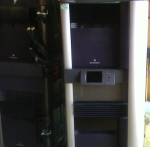I just picked one up (I had a software idea and couldn't resist - so far development is going quite well with the exception of the hackiness of my scheme to avoid paying Apple another $99 for a developer account). I just grabbed the $499 WiFi model - $629 + $20/month is definitely a lot more than I can spend on an iPad.
I must say it grows on me with every second I use it. I'm still not enamored with it, nor do I think it's a "magical revolution" (more an obvious evolution) or something everyone should have. But I've spent $500 in a lot of stupider ways, and it is without a doubt the best "laying around in bed checking out the web / watching movies / listening to music / reading books" device I've ever owned or seen.
The biggest minuses so far have been the packaging and what was (or rather wasn't) included, and its appeal to everyone around me. I was sorely disappointed by the packaging - my 2010 Macbook Pro had a lot less wasted space in the box and came with at least a cleaning cloth. Analysts have pegged the per-device margin for Apple at over $200 even for the lower-end iPads - at that rate, was $5 for a cleaning cloth and stand or something really too much? I know Apple love selling overpriced accessories, but there's a balance between what you force people to buy and making your consumer feel shafted when they unpack their new device, and I think Apple swung the balance a little too minimalist with the iPad.
And the iPad is *way* too attractive to people around me (even ones who have already used one, own one, or have decided never to buy one) - it's proven near-impossible to get anything done with it myself so far as I've been letting all my friends take it for a spin instead.
At any rate, my buyer's remorse is wearing off as my code gets better (I'm hoping to make at least the cost of the iPad back) so all is well

 <>
<>








